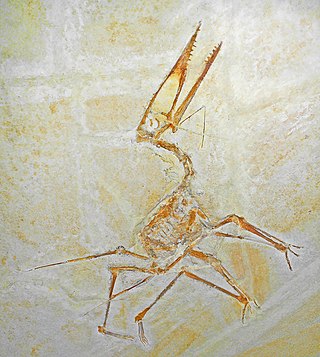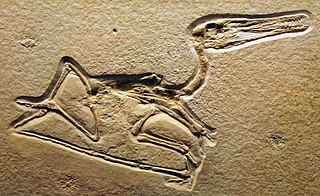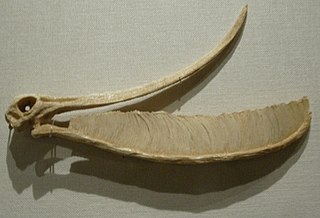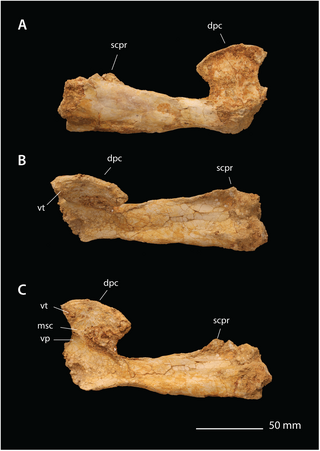
Germanodactylus is a genus of germanodactylid pterodactyloid pterosaur from Upper Jurassic-age rocks of Germany, including the Solnhofen Limestone. Its specimens were long thought to pertain to Pterodactylus. The head crest of Germanodactylus is a distinctive feature.

Pterodactyloidea is one of the two traditional suborders of pterosaurs, and contains the most derived members of this group of flying reptiles. They appeared during the middle Jurassic Period, and differ from the basal rhamphorhynchoids by their short tails and long wing metacarpals. The most advanced forms also lack teeth, and by the late Cretaceous, all known pterodactyloids were toothless. Many species had well-developed crests on the skull, a form of display taken to extremes in giant-crested forms like Nyctosaurus and Tupandactylus. Pterodactyloids were the last surviving pterosaurs when the order became extinct at the end of the Cretaceous Period, together with the non-avian dinosaurs and most marine reptiles.

Gallodactylidae is a group of pterosaurs within the suborder Pterodactyloidea. Gallodactylids differed from other related pterosaurs in several distinct features, including fewer than 50 teeth present only in the jaw tips, and rounded crests present on the rear portion of the skull and jaws but not near the ends of their snouts. At least some species possessed jaw flanges, possibly used to bissect hard-shelled prey.
Boreopterus is a genus of boreopterid pterodactyloid pterosaur from the Barremian-Aptian-age Lower Cretaceous Yixian Formation of Dalian, Liaoning, China.
Eoazhdarcho is a genus of azhdarchoid pterodactyloid pterosaur named in 2005 by Chinese paleontologists Lü Junchang and Ji Qiang. The type and only known species is Eoazhdarcho liaoxiensis. The fossil was found in the Aptian-age Lower Cretaceous Jiufotang Formation of Chaoyang, Liaoning, China.

Diopecephalus is a genus of pterodactyloid pterosaur from the Lower Tithonian of the Lithographic Limestone, Bavaria, Germany. The type and only species is D. kochi, although the name has been applied to Pterodactylus longicollum, with longicollum erroneously listed as the type species.
Normannognathus is a genus of pterosaur from the Kimmeridgian-age Upper Jurassic Argiles d'Octeville Formation of France. Initially, Normannognathus was classified to the family Germanodactylidae, sister taxon to Germanodactylus, however, many recent analysis have recovered Normannognathus in different phylogenetic positions, and depending on different authors, Normannognathus is either found as a basal member of the Dsungaripteroidea, as an indeterminate monofenestratan, or as the sister taxon of Cycnorhamphus within the family Gallodactylidae.

Ornithocheiroidea is a group of pterosaurs within the extinct suborder Pterodactyloidea. They were typically large pterosaurs that lived from the Early to Late Cretaceous periods, with fossil remains found all over the world except Antarctica.

Ctenochasmatoidea is a group of early pterosaurs within the suborder Pterodactyloidea. Their remains are usually found in what were once coastal or lake environments. They generally had long wings, long necks, and highly specialized teeth.

Dsungaripteroidea is a group of pterosaurs within the suborder Pterodactyloidea.

Euctenochasmatia is an extinct group of pterodactyloid pterosaurs. It was named by David Unwin in 2003 as the group that contains the most recent common ancestor of Pterodactylus and Ctenochasma, and all their descendants.

Boreopteridae is a group of pterodactyloid pterosaurs from the Aptian-age Lower Cretaceous Yixian Formation of Liaoning, China.

Eupterodactyloidea is an extinct group of pterodactyloid pterosaurs that existed from the latest Late Jurassic to the latest Late Cretaceous periods. Eupterodactyloids lived on all continents except Antarctica.

Archaeopterodactyloidea is an extinct clade of pterodactyloid pterosaurs that lived from the middle Late Jurassic to the latest Early Cretaceous periods of Africa, Asia, Europe and North America. It was named by Alexander Wilhelm Armin Kellner in 1996 as the group that contains Germanodactylus, Pterodactylus, the Ctenochasmatidae and the Gallodactylidae. In 2003, Kellner defined the clade as a node-based taxon consisting of the last common ancestor of Pterodactylus, Ctenochasma and Gallodactylus and all its descendants. Although phylogenetic analyses that based on David Unwin's 2003 analysis do not recover monophyletic Archaeopterodactyloidea, phylogenetic analyses that based on Kellner's analyses, or the analyses of Brian Andres recover monophyletic Archaeopterodactyloidea at the base of the Pterodactyloidea.

Novialoidea is an extinct clade of macronychopteran pterosaurs that lived from the latest Early Jurassic to the latest Late Cretaceous, their fossils having been found on all continents except Antarctica.

Ornithocheirae is an extinct clade of pteranodontoid pterosaurs from the Early Cretaceous to the Late Cretaceous of Asia, Europe, North America and South America. It was named by Harry Seeley in 1870 as a family that contains Ornithocheirus and its relatives. The name was emended to Ornithocheiridae, to match the requirements of the ICZN Code that a family-ranked clade should end with an -idae suffix. Brian Andres (2010) in his review of pterosaur phylogeny, defined the name Ornithocheirae phylogenetically, as a node-based taxon consisting of the last common ancestor of Anhanguera and Ornithocheirus and all its descendants. Thus Ornithocheirae is defined to include two families, the Anhangueridae and the Ornithocheiridae, following the opinion of Alexander Kellner and Andres that these families should not be synonymized based on their original phylogenetical definitions. However, subsequent studies in 2019 have found Ornithocheirae to be a more inclusive group containing both Anhangueria and Targaryendraconia.

Anhangueria is a group of pterosaurs belonging to the clade Pteranodontoidea. Fossil remains of this group date back from the Early to Late Cretaceous periods, around 140 to 92.5 million years ago. Anhangueria was named by paleontologists Taissa Rodrigues and Alexander Kellner in a review of Ornithocheirus species in 2013, they defined the clade as a branch-based taxon consisting of all pteranodontoids more closely related to Anhanguera blittersdorffi than to Istiodactylus latidens and Cimoliopterus cuvieri.
Alamodactylus is an extinct genus of nyctosaurid pteranodontoid pterosaur known from the Late Cretaceous of Texas, southern United States. It contains a single species, Alamodactylus byrdi.

Kryptodrakon is an extinct genus of pterodactyloid pterosaur from the Middle to Late Jurassic with an age of approximately 162.7 million years. It is known from a single type species, Kryptodrakon progenitor. The age of its fossil remains made Kryptodrakon the basalmost and oldest pterodactyloid known to date.

Simurghia is a genus of pterosaur from the Ouled Abdoun Basin of Morocco, a basin that dates to the Maastrichtian stage of the Late Cretaceous period, about 66 million years ago. It was published in 2018 by paleontologists Nicholas R. Longrich, David M. Martill, and Brian Andres, along with two other pterosaurs from the same basin: Alcione and Barbaridactylus. The type and only species is S. robusta.





























